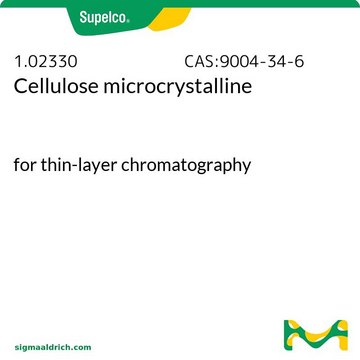22197
Cellulose
DS-0, powder, suitable for thin layer chromatography (TLC)
Sinónimos:
Cellulose powder, Cotton linters
About This Item
Productos recomendados
Nivel de calidad
Formulario
powder
técnicas
thin layer chromatography (TLC): suitable
residuo de ign.
≤0.1%
pérdida
≤5% loss on drying
cadena SMILES
O1[C@H](C(C(C(C1CO)O)O)O)O[C@@H]2C(OC(C(C2O)O)O)CO
InChI
1S/C12H22O11/c13-1-3-5(15)6(16)9(19)12(22-3)23-10-4(2-14)21-11(20)8(18)7(10)17/h3-20H,1-2H2/t3?,4?,5?,6?,7?,8?,9?,10-,11?,12+/m1/s1
Clave InChI
GUBGYTABKSRVRQ-WFVLMXAXSA-N
¿Está buscando productos similares? Visita Guía de comparación de productos
Descripción general
Aplicación
Código de clase de almacenamiento
11 - Combustible Solids
Clase de riesgo para el agua (WGK)
WGK 1
Punto de inflamabilidad (°F)
Not applicable
Punto de inflamabilidad (°C)
Not applicable
Equipo de protección personal
Eyeshields, Gloves, type N95 (US)
Elija entre una de las versiones más recientes:
Certificados de análisis (COA)
¿No ve la versión correcta?
Si necesita una versión concreta, puede buscar un certificado específico por el número de lote.
¿Ya tiene este producto?
Encuentre la documentación para los productos que ha comprado recientemente en la Biblioteca de documentos.
Los clientes también vieron
Nuestro equipo de científicos tiene experiencia en todas las áreas de investigación: Ciencias de la vida, Ciencia de los materiales, Síntesis química, Cromatografía, Analítica y muchas otras.
Póngase en contacto con el Servicio técnico


